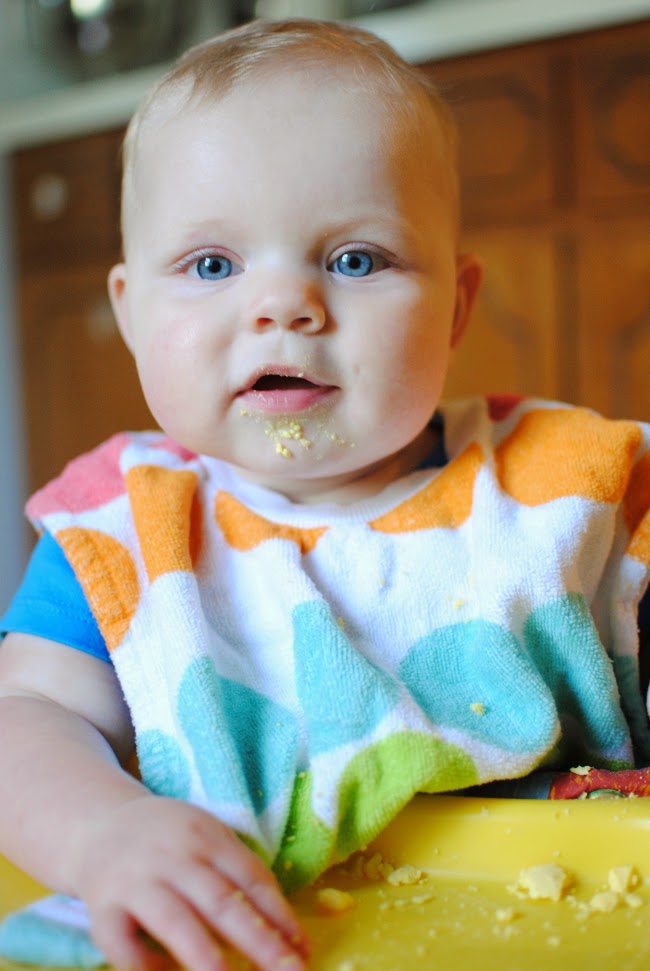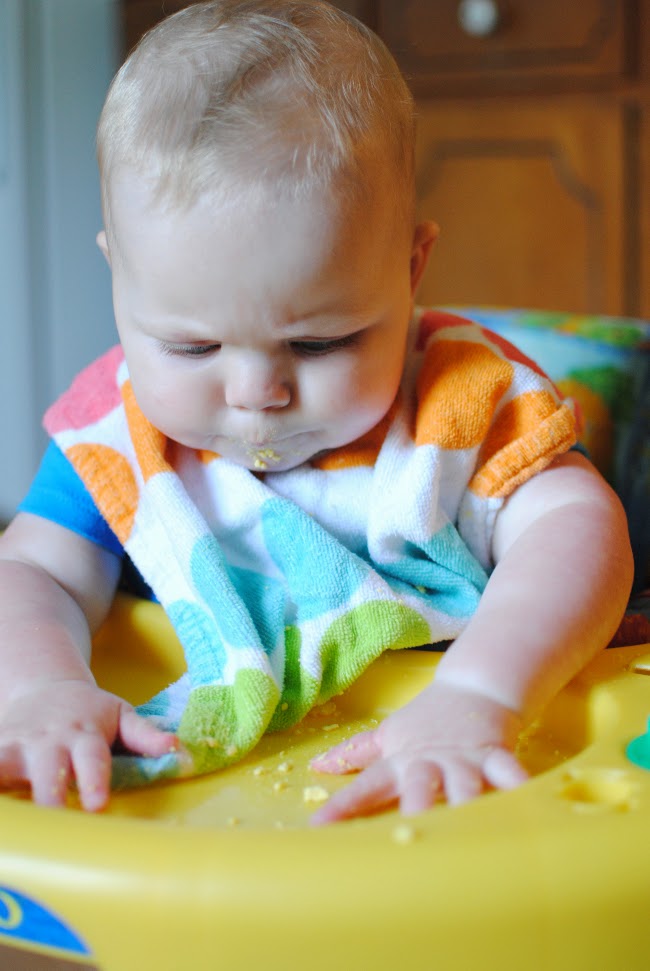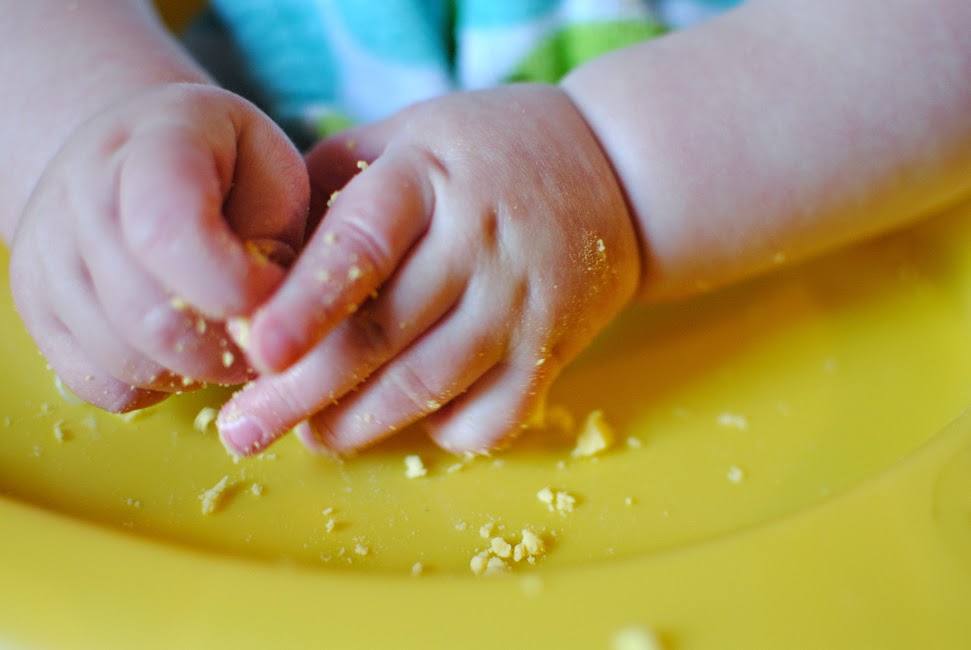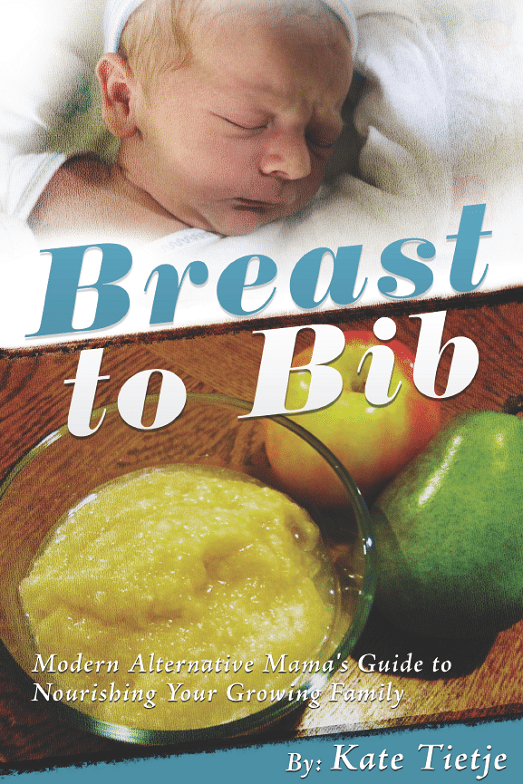My kids love to eat real food.
Raw veggies. Hummus. Salad. Fruit. Chicken. Beef. Eggs. Fancy cheese. Sweet potatoes. Quinoa. Brown rice. Pumpkin. Wheat bread. Beans. They eat it all (and love it).
I’ve had many moms ask me how to raise kids who love to eat real food, and today I want to share what our family has done. I don’t write this post with pride or a guarantee that it will work for your family, but I share it with a strong desire to help other families.
 I do want to add this word of disclaimer: First of all, I am not a medical professional, so please speak to your primary care provider if you have concerns about your child’s eating habits and health. Follow their advice. Secondly, there are some instances where these tips won’t help. If you’re feeling desperate and you’ve tried all of these things already, know that I sympathize with you. You’re doing a great job! I don’t want this post to come across as a one-size-fits-all approach.
I do want to add this word of disclaimer: First of all, I am not a medical professional, so please speak to your primary care provider if you have concerns about your child’s eating habits and health. Follow their advice. Secondly, there are some instances where these tips won’t help. If you’re feeling desperate and you’ve tried all of these things already, know that I sympathize with you. You’re doing a great job! I don’t want this post to come across as a one-size-fits-all approach.
And one more thing before I jump in… we have dealt with pickiness in all of our older children at various seasons. It hasn’t lasted very long, but it did seem to be at its peak between eighteen months and two years, and then another spike right at three years. We just kept doing what we’d been doing, ignoring the pickiness for the most part and carrying on with mealtime as usual!
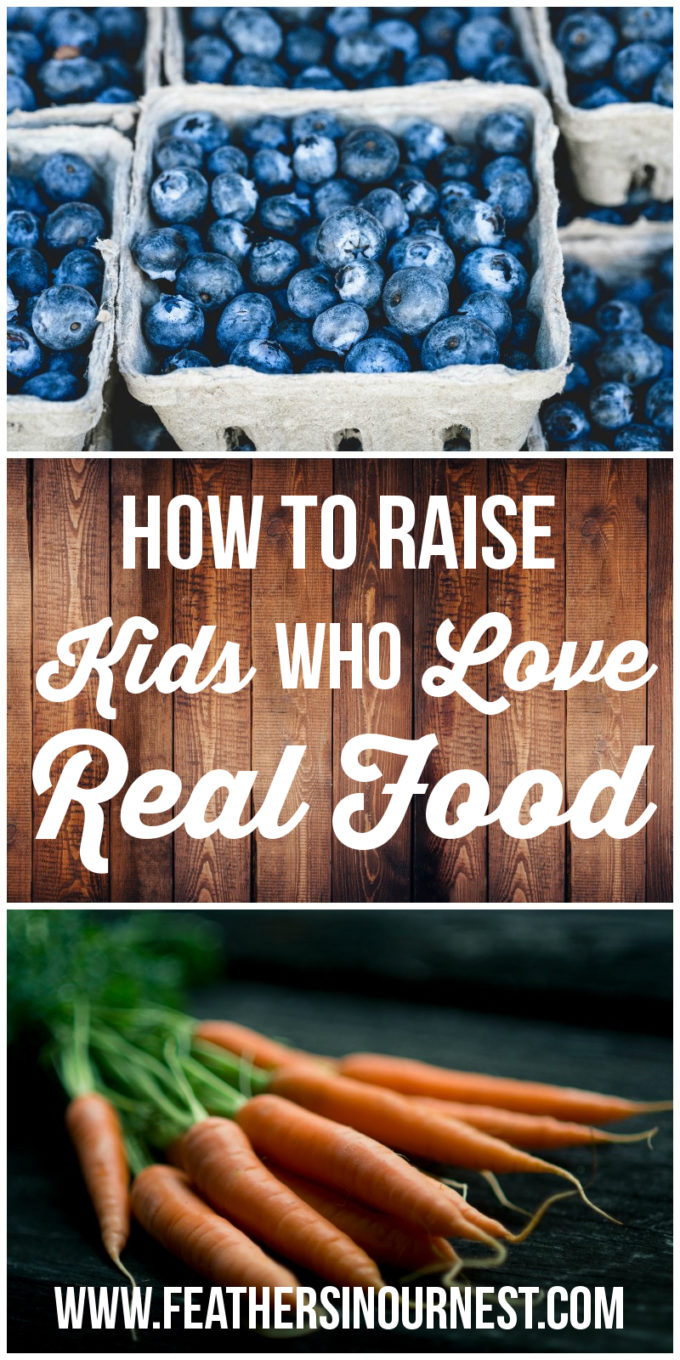
How to Raise Kids Who Love to Eat Real Food
Start young
We begin the process of raising kids who love real food when our babies are tiny. When we start solid foods, we actually start solid foods, meaning we completely skip purees and commercial baby food. Have you ever tasted baby food? Even if you get a premium brand, the flavors are quite bland, and, of course, the texture is the same regardless of the flavor. Instead of offering purees, we give our little ones a wide variety of table foods (i.e., what the rest of us are eating for dinner) and let them experience many flavors and textures (and feeding themselves). This stage begins around 7-8 months, depending on the child and their readiness (sitting up on own, able to chew and swallow without gagging, etc.). Good starter foods (assuming you don’t know of any allergies) include egg yolks, avocado, bananas, soft cheese, peas, chicken, yogurt, and hummus. Always make sure the pieces are small and that you don’t put too much on their tray at one time. Even if they don’t have teeth yet, they’ll be able to chew this food with their gums! Just keep a close eye on them so they don’t put too much in their mouth at once.
Serve up variety
Be adventurous in your cooking! Don’t assume that just because they are kids that they won’t like more sophisticated dishes. Give your kids a chance to experience flavors from around the world: curry, salsa, hummus, tzatziki, strong cheeses, spicy peppers, arugula, olives, sauerkraut, etc. They may not like it initially (or they may surprise you!), but it’s always good for them to try it. I’ve heard friends tell me that their kids won’t eat the food they make (“It’s just plain chicken!”), and I’ve sometimes wondered if the food is actually too bland rather than too “spicy.” Raise kids who love to eat real food… vegetables, fruit, meat, whole grains, eggs, cheese, yogurt, etc. by feeding them flavorful, delicious meals they can’t resist!
Get used to green things
I throw “green things” on my kids’ plates almost every meal. Basil in their scrambled eggs. Parsley on their soup. Arugula on their pizza. You get the idea! I’ve been doing this since they knew their colors (ha), so I’ve never dealt with the “I don’t like these green things” line. Green things are good and a part of life!
Set some family meal time ground rules
Over the years, our family has established some rules that apply to meals at our house. We’ve picked these up from various places, and they are second-nature around our table now. Our kids know what to expect. I do think it’s important to point out that my husband and I model all of these things to our children. We don’t necessarily love every food in existence, but we abide by these rules too.
Here are our family meal time ground rules:
We all eat the same meal
I do not cook separate “kid meals.” The only exception to this is when we’re eating up leftovers and we all pick what we’re going to eat from the fridge.
This might sound harsh, but if you feed your kids chicken nuggets, mac and cheese, and French fries when they don’t eat the meal you prepared, they will learn to refuse the food you cook, knowing that you will make them something they want. Don’t get caught up in this cycle. Make the same food for everyone (with some modifications for preferences, like choosing their own toppings on taco night, or their own salad dressing, etc.) and everyone will learn that you expect them to eat what you cook.
We decide what goes on your plate, and you can decide how much of it you eat
I picked up this tip from my sister-in-law, and it works wonderfully! I give everyone a portion, and they can decide whether to eat it all of it or not. It’s their choice. No battle necessary! We don’t expect them to completely “clean their plates.” (Note: I plate all of the food in the kitchen before the meal begins. We don’t eat “family-style” very often.)
You don’t have to like it, but you do have to try it
We do expect a tasting bite of new foods, but I rarely have to remind anyone of this rule anymore. Trying all the food on our plates is just what we do! Learning to like a new food can take a dozen or so times of trying it, so keep giving your kids the food you cook and eventually they will probably learn to like it! (This works for adults, too!)
You may have seconds of what you like when you finish eating everything on your plate
This is an easy one. If you want more of the food you love (a biscuit, for example), you will need to first finish the rest of the food we served you (your soup, for example). Sometimes our kids will finish up the rest of their food so they can have seconds of the food they really loved, and other times they choose not to. It’s their choice. No one has starved yet (or even missed a meal).
This rule also applies to the times we have dessert (which is not at every meal). They need to eat their food before they can have dessert.
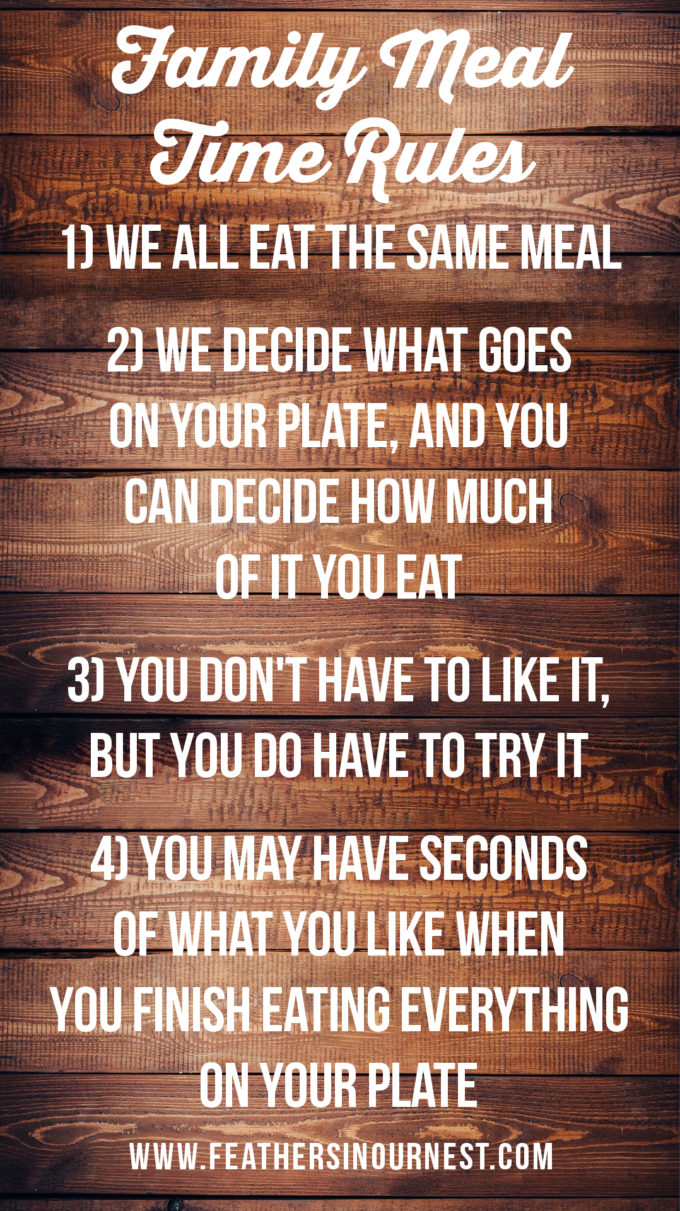
Be enthusiastic
When your kids see you excited about trying new foods, anticipating eating a meal, and talking about how much you enjoy the flavors of the food, your enthusiasm will (eventually) wear off on them! My husband and I are about as enthusiastic about food as it gets, so our kids have naturally become like us in this area. Don’t be afraid to praise your own cooking in front of your kids (“WOW! Isn’t this beef stew delicious?!”), as it helps them get excited about the meal also and learn to express appreciation to the chef.
Let them pick
Occasionally, ask for input when meal planning. Find out what their favorite meals are and try to have those in your regular rotation. My kids love homemade pizza, so we make pizza every Friday, exploring fun new toppings almost every time! They can also help you pick out produce at the farmer’s market, the grocery store, or a u-pick farm. They might be more likely to try a new fruit or vegetable that they selected!
Get them involved
Let your kids help in the kitchen! Even simple tasks like grating cheese, slicing bananas, putting sandwiches on the plates, etc. can make them feel invested in the meal. Our dinner helper takes great pride in the meal that he or she has helped “make”! Eventually, they will learn to be real helpers in the kitchen. Get them interested now!
Cut down on snacking
If you give your child an applesauce squeeze pouch before breakfast, a bagel mid-morning, a big cup of milk and a string cheese in the afternoon, you may find that they do not eat as much at mealtimes. (Yes, milk counts as a snack!) We don’t have any snacking before breakfast or in the afternoons (but everyone will have to make those decisions for their own families). We do a small morning snack (usually in-season fruit), but other than that, we don’t snack. By dinner time, the kids are very hungry for dinner, which makes them less likely to be picky about eating it! Again, you have to find what works for your family, but if your child isn’t eating well at mealtimes, you may want to try cutting out in-between meal snacking (or just serving fresh veggies and/or fruit). We also just drink water with our meals as opposed to milk or juice.
So those are my best tips for how to raise kids who love to eat real food! I have four really great eaters, but they’re not perfect, of course. We definitely have days when the food I make isn’t particularly popular, and we have seasons where one child will decide they no longer like a food they used to enjoy. We try not to sweat it, and just keep doing what we’ve been doing! So far it seems to be working!
If you’re looking for more resources to help raise kids who love to eat real food, check out these cookbooks!
Disclosure: This post contains affiliate links.
